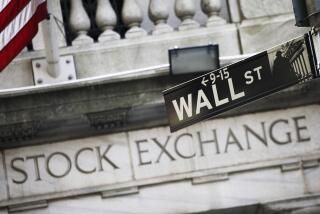Gold Touches $500 Level
- Share via
Gold, the fashion accessory that became grossly out of style on Wall Street in the 1990s, passed a new milepost in its comeback Tuesday.
The metal traded above $500 an ounce, a price last reached in 1987, extending a rally that has made it one of this decade’s star investments.
However, holiday jewelry shoppers may be insulated from the latest price surge, which has lifted gold from $460 an ounce at the start of the month. Many retailers are selling gold that they bought at lower cost, so consumers may not see escalating prices in the next few weeks.
“Consumers won’t feel it until gold rises to $600 or $800,” said Elie Semaan, owner of Glendora-based online jewelry dealer 14KZone.com.
At the Commodity Exchange in New York, gold futures contracts for December delivery rose as high as $502.30 an ounce Tuesday before pulling back to close at $499.10, up 80 cents for the day. The futures price is a global benchmark for the metal.
Gold has nearly doubled since the spring of 2001, in a steady climb that analysts say reflects a confluence of favorable factors, including strong jewelry demand in up-and-coming economies such as India. Jewelry accounts for about 75% of annual consumption of the metal, according to the World Gold Council, a trade group.
Many analysts also point to a growing desire by many institutional and individual investors worldwide to add gold to their portfolios as a basic diversification move.
Although stocks, bonds and real estate still constitute the bulk of investors’ portfolios, gold’s historical role as a way to preserve wealth has gained new appreciation in recent years, said Bill Martin, co-manager of the American Century Investments Global Gold stock mutual fund in Mountain View, Calif.
In particular, the metal has benefited as some investors have become more concerned about the U.S. dollar’s value -- amid fears that the currency could sink over time under the weight of the nation’s record trade and budget deficits.
“Gold is definitely taking on an alternative-currency role,” Martin said.
Dennis Gartman, a veteran gold analyst at the Gartman Letter in Suffolk, Va., said he expected central banks of some emerging economies to boost their gold holdings at the expense of the dollar and other major currencies.
Indeed, the falling dollar was one factor driving gold higher in 2003 and 2004. Yet this year, gold has continued to rise even as the dollar has rebounded against the euro and the yen.
Martin said the metal’s continuing rally, despite the dollar’s recovery, has reinforced the idea that gold is coming back into its own as an investment option.
Gold’s revival since 2001 followed 20 years of mostly declining prices. The hyperinflation fears of the late 1970s drove the metal to a record high of more than $800 an ounce in 1980. Gold long has been viewed as a hedge against inflation and economic instability.
But as inflation fell throughout the 1980s and 1990s, interest in gold faded. The roaring bull markets in stocks and bonds in those decades left precious metals and other commodities with few fans. Gold slumped below $255 an ounce in 1999.
Over the last few years, however, some investors have seen gold in a different light.
“We are seeing mainly sophisticated investors who have made a lot of money in the stock market and real estate, who are now looking for a safe haven to protect what they’ve earned,” said Ryan Denby, sales manager at Austin Rare Coins & Bullion in Austin, Texas. “People are taking a defensive position. They know from history that in times of economic distress, gold has always done very well.”
The energy-induced pickup in inflation since 2003 also has helped boost gold, analysts say.
Gold purchased for investment, such as in the form of coins or bars, totaled 430 tons in the first nine months of this year, up 62% from a year earlier, World Gold Council data show. By contrast, jewelry demand was up 12% in the period, to 2,027 tons.
A major driving force in the latest gold investment wave is a new type of stock mutual fund that allows investors to directly own bullion through the purchase of fund shares.
The most popular such fund in the U.S. is the StreetTracks Gold Trust, which was introduced a year ago and trades on the New York Stock Exchange.
The fund’s assets have swelled to $3.7 billion in a year.
Traditionally, most gold-oriented mutual funds have invested in stocks of gold mining companies rather than in the metal itself.
Inevitably when gold rallies, it stirs excitement among so-called gold bugs -- people who believe that a global cataclysm is imminent and that precious metals will be the only investment that will have any value when Armageddon comes.
Gartman says that the doomsday brigade makes it harder for some mainstream investors to take gold seriously.
“Most of the gold bugs are convinced the world is coming to an end,” Gartman said. “I don’t wish to be associated with those people.”
Although he is optimistic that gold can continue to rise in coming years as more investors add it to their portfolios, Gartman said there was always the risk that speculators jumping into the market would drive prices to levels that fundamental demand, such as for jewelry, can’t sustain in the short term.
Analysts also note that the price of gold, like prices of all commodities, will depend on how much supply is on the market at any moment. And with the surge in the metal’s price, it has become much more lucrative for mining companies to expand exploration worldwide.
More to Read
Inside the business of entertainment
The Wide Shot brings you news, analysis and insights on everything from streaming wars to production — and what it all means for the future.
You may occasionally receive promotional content from the Los Angeles Times.










